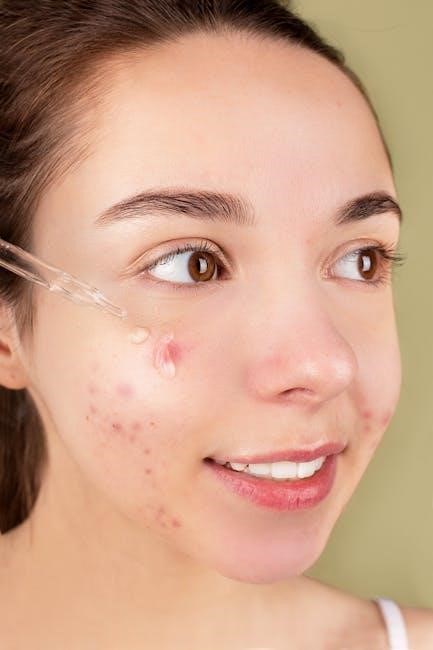a girl’s guide to puberty

Puberty is a natural journey of physical and emotional growth, marking the transition from childhood to adulthood. It’s a time of change, discovery, and empowerment for girls.
1.1 What is Puberty?
Puberty is a natural process where a girl’s body matures into a woman’s body. It typically begins between ages 8 and 14, triggered by hormone changes. Key physical changes include breast development, growth spurts, and the appearance of body hair. Emotional shifts, such as mood swings, may also occur. Puberty signals the start of menstrual cycles, preparing the body for future fertility. While the journey can feel overwhelming, understanding these changes helps girls embrace this transition confidently. Open conversations and proper guidance are essential to navigate this phase smoothly.
1.2 Why is Puberty Important?
Puberty is a critical phase of development, marking the transition from childhood to adulthood. It prepares the body for reproduction and long-term health. Understanding puberty empowers girls to embrace their growth confidently, fostering resilience and self-esteem. This period shapes emotional and social development, influencing relationships and identity. Recognizing its importance helps girls navigate physical and emotional changes, ensuring a smooth transition into womanhood. Education and support during puberty are vital for fostering confidence and preparing girls for future challenges. It’s a foundation for lifelong health and well-being, making it essential to approach this stage with knowledge and openness.

Physical Changes During Puberty
Puberty brings significant physical changes, including breast development, growth spurts, and body hair. Girls experience hip widening, acne, and increased body odor, marking their transition to adulthood.
2.1 Breast Development
Breast development is often the first sign of puberty in girls, typically beginning around age 8. Small bumps under the nipple, called breast buds, signal the start. It’s normal for one breast to develop before the other, and they may feel tender. This process, driven by hormones like estrogen, can take 2-5 years to complete. Girls may notice their breasts growing unevenly at first, but this usually balances out. It’s important to reassure them that this is a natural part of growth. Breast development is a key milestone, marking the beginning of physical changes that will continue through adolescence.
2.2 Growth of Body Hair
During puberty, girls begin to notice the growth of body hair, particularly in the genital area, underarms, and on the legs. This hair is usually coarse and darker than the fine hair previously present. For some girls, pubic hair may appear before breast development, while for others, it may come later. The growth of body hair is driven by hormonal changes, especially the increase in estrogen and androgens. As puberty progresses, the hair becomes thicker and spreads to other areas, such as the arms and around the nipples. This natural process can sometimes lead to questions about shaving or trimming, which are personal choices. Girls may start shaving their legs or underarms, and using shaving gel or lotion is recommended to avoid irritation. It’s important to approach this change with confidence and understand that it’s a normal part of growing up.
2.3 Growth Spurt
The growth spurt is one of the most noticeable changes during puberty. Girls typically experience their fastest growth between the start of breast development and about six months before their first period. On average, girls grow 1-2 inches annually during puberty, with the most significant growth occurring in the first few years. This rapid growth is driven by hormonal changes, particularly the surge in estrogen. By the end of puberty, most girls have reached about 98% of their adult height. The growth spurt is a key part of development, shaping their adult stature and body proportions. Understanding this phase helps girls embrace the transformation with confidence and patience.
2.4 Changes in Hip and Waist
During puberty, girls experience significant changes in their hip and waist structure. Hips typically widen, while the waist may become more defined and narrower. This transformation is driven by hormonal changes, particularly estrogen, which promotes fat distribution to the hips and breasts. These changes help shape the female silhouette and prepare the body for potential future roles, such as childbirth. While individual variations exist, this shift in proportions is a natural part of development. It’s important for girls to embrace these changes and understand that every body develops differently. These physical adjustments are a key part of maturing into a healthy, adult form.

Menstrual Cycle
The menstrual cycle is a natural process where the body prepares for potential pregnancy. It begins with the first period, typically around age 12, and repeats monthly.
3.1 Preparing for the First Period
Preparing for the first period is an essential step in a girl’s journey through puberty. Most girls get their first period around age 12, but it can vary. Education and awareness are key to feeling confident and ready. Stocking up on sanitary products like pads or tampons, and knowing how to use them, is crucial. Many girls start with pads for ease and switch to tampons later. Understanding the cycle and tracking it can help anticipate the first period. Encourage open conversations with parents or guardians to address fears or questions. Small steps, like keeping supplies in a backpack, can reduce anxiety. Remember, it’s a natural process, and being informed helps ease the transition.
3.2 Understanding the Menstrual Cycle
The menstrual cycle is a monthly process controlled by hormones, preparing the body for potential pregnancy. It begins with the follicular phase, where the uterus thickens, and ends with menstruation if pregnancy doesn’t occur. The average cycle lasts 21-35 days, with most girls experiencing a 28-day cycle. Hormonal changes trigger ovulation, releasing an egg for fertilization. Symptoms like mood swings, bloating, and fatigue often occur pre-menstrually. Tracking the cycle helps manage symptoms and predict periods. Understanding this natural process empowers girls to take charge of their health and well-being.
3.3 Managing Menstrual Symptoms
Menstrual symptoms like cramps, bloating, and mood swings can be challenging but manageable. Over-the-counter pain relievers such as ibuprofen or naproxen can ease cramps. Applying a heating pad to the lower abdomen may also provide relief. Staying hydrated and maintaining a balanced diet can help reduce bloating and fatigue. Light exercise, such as walking or yoga, can improve mood and reduce discomfort. Practicing relaxation techniques like deep breathing or meditation can help manage emotional changes. It’s important to prioritize rest and self-care during this time. Encourage open conversations about symptoms to ensure support and understanding. Tracking the menstrual cycle can also help anticipate and prepare for symptoms, making management easier and more effective.

Emotional and Social Changes
Puberty brings emotional shifts, like mood swings, and social challenges, such as peer pressure. Building self-esteem and open communication can help girls navigate these changes confidently.
4.1 Mood Swings and Emotional Changes
During puberty, girls often experience mood swings due to hormonal changes. Emotional ups and downs, irritability, and sensitivity may arise as estrogen levels fluctuate. These feelings are normal and temporary. Physical changes, such as breast development and body hair growth, can also contribute to emotional shifts. Open communication with trusted adults helps girls navigate these changes. Encouraging self-expression and providing reassurance can foster emotional resilience. Understanding that these feelings are part of growing up can alleviate anxiety. Parents and guardians play a key role in offering support and guidance during this transitional phase.
4.2 Building Self-Esteem
Building self-esteem during puberty is crucial for girls to navigate this transitional phase confidently. Positive affirmations and open conversations about body changes can help girls embrace their growth. Encouraging girls to focus on their strengths and accomplishments fosters resilience. Parents and guardians should create a supportive environment where girls feel valued and heard. Celebrating individuality and promoting body positivity are key to helping girls develop a healthy self-image. Providing resources like books or guides can empower them with knowledge and confidence. By fostering self-acceptance, girls can build a strong foundation for emotional well-being and self-assurance as they grow into adulthood.
4.3 Social Challenges and Peer Pressure
During puberty, girls often face social challenges and peer pressure, which can impact their self-confidence and decision-making. Body changes, hormonal shifts, and the desire to fit in can create anxiety. Girls may feel pressured to conform to certain standards or behaviors, especially regarding appearance and social acceptance. Open communication with parents, educators, and friends can help girls navigate these challenges. Encouraging girls to focus on their individual strengths and values fosters resilience. It’s important to remind them that everyone grows at their own pace and that diversity is normal. Building a supportive network and promoting positive relationships can help girls thrive during this transitional phase.

Health and Hygiene
Puberty brings significant changes, making health and hygiene essential for confidence and well-being. Regular skincare, haircare, and use of deodorants help manage body changes and promote self-care routines.
5.1 Skincare Routine
During puberty, hormonal changes can lead to acne and oily skin. A consistent skincare routine helps maintain healthy skin. Wash your face twice daily with a gentle cleanser to remove dirt and oil. Use non-comedogenic products to avoid clogging pores. Moisturize to keep skin hydrated, even if it’s oily. Exfoliate once a week to remove dead skin cells but avoid over-exfoliating, which can irritate the skin. If acne persists, consider using products with salicylic acid or benzoyl peroxide. Avoid touching your face to prevent transferring bacteria. Remove makeup thoroughly before bed to prevent breakouts. If skin issues worsen, consult a dermatologist for advice.
5.2 Haircare Tips
During puberty, increased oil production and sweat can affect hair health. Wash your hair regularly with a gentle shampoo suitable for your hair type. Use conditioner to keep hair soft and manageable. Avoid excessive heat styling to prevent damage. If you swim, rinse your hair thoroughly to remove chlorine. For curly hair, use products that enhance natural texture. Brush or comb gently, especially when wet, to minimize breakage. Keep your scalp clean to prevent dandruff or irritation. Trim split ends regularly to maintain healthy hair growth. If you choose to shave, shave in the direction of hair growth and use a sharp razor with shaving gel to avoid irritation. Proper haircare helps boost confidence and keeps your hair looking its best.
5.3 Using Deodorants and Antiperspirants
During puberty, increased sweat and body odor are common due to hormonal changes. Using deodorants or antiperspirants can help manage this. Deodorants reduce odor, while antiperspirants minimize sweat. Choose a product that suits your skin type and preferences. Apply it daily, preferably after showering, to stay fresh. If you have sensitive skin, opt for fragrance-free options. Remember, it’s important to shower regularly and wear clean clothes to maintain hygiene. Don’t forget to reapply after physical activity or sweating heavily. Using these products helps boost confidence and keeps you feeling fresh throughout the day. Embrace this small but significant step in your daily routine!

When to See a Doctor
Consult a pediatrician if puberty starts before age 8 or hasn’t begun by 13, or if there are concerns about weight gain or severe menstrual cramps.
6.1 Early or Late Puberty
Puberty typically begins for girls between ages 8 and 13, but timing can vary due to genetics, nutrition, and overall health. Early puberty, starting before age 8, or late puberty, with no signs by age 13, may warrant a pediatrician’s evaluation. Factors like obesity or being born small for gestational age can influence early onset, while genetic factors often delay it. Monitoring growth and development is crucial, as early or late puberty can affect physical and emotional well-being. Consulting a doctor helps address concerns and ensures proper guidance for a healthy transition through this stage.
6.2 Concerns About Weight Gain
Weight gain during puberty is normal due to increased body fat and hormonal changes. Girls typically gain weight in the hips and breasts, which is part of healthy development. However, excessive or rapid weight gain can be a concern. Factors like genetics, nutrition, and physical activity levels play a role. If weight gain crosses percentile lines on a growth chart or exceeds the 85th percentile in body mass index (BMI), it may indicate a need for lifestyle adjustments. Healthy habits, such as balanced eating and regular exercise, should be encouraged early. Consulting a pediatrician can provide guidance on maintaining a healthy weight and addressing any concerns about growth patterns during puberty.
6.3 Severe Menstrual Cramps
Severe menstrual cramps, known as dysmenorrhea, can be painful and disrupt daily activities. They are caused by uterine contractions and hormonal changes. Over-the-counter pain relievers like ibuprofen or naproxen are often effective. If cramps are severe and persistent, a pediatrician may recommend prescription options or further evaluation. Encourage open communication about symptoms to ensure proper care and comfort during this time.

Talking to Parents or Guardians
Open and honest conversations with parents or guardians about puberty are crucial. They provide reassurance, guidance, and support, helping girls navigate changes with confidence and trust.
7.1 Open Communication About Puberty
Open communication about puberty is essential for building trust and confidence. Parents or guardians should create a safe space for girls to ask questions and express feelings. Encourage honest conversations about body changes, emotions, and concerns. Provide accurate information and reassurance to ease anxiety. Discuss topics like menstrual health, hygiene, and emotional shifts early on. Offer practical advice, such as managing periods and using sanitary products. Emphasize that it’s okay to seek help or guidance. Parents don’t need all the answers but should be willing to learn alongside their child. Open dialogue fosters a supportive environment, helping girls navigate puberty with confidence and understanding.

7.2 Discussing Menstrual Health
Discussing menstrual health openly is crucial for helping girls understand and manage their periods. Explain what to expect during the menstrual cycle, including the duration, flow, and possible symptoms like cramps or mood swings. Emphasize the importance of hygiene, such as using sanitary pads, tampons, or menstrual cups, and how to change them regularly. Provide tips for tracking cycles and preparing for unexpected periods. Address any fears or misconceptions about menstruation, reassuring girls it’s a natural process. Encourage them to ask questions and seek help if they experience heavy bleeding, severe pain, or irregular cycles. Open conversations about menstrual health foster confidence and readiness for this significant life change.
7.3 Seeking Advice on Body Changes
Seeking advice on body changes during puberty is essential for girls to feel supported and informed. Encourage open conversations with parents or guardians about physical and emotional developments. Parents should be approachable, providing reassurance and factual information to ease concerns. Discussing topics like hygiene, managing symptoms, and when to consult a doctor can empower girls to take charge of their health. Emphasize the importance of self-care and self-acceptance during this transition. Creating a safe and non-judgmental environment fosters trust and helps girls navigate changes confidently. Remind them that seeking advice is a sign of strength, not weakness, and that they are not alone in this journey.

Maintaining a Healthy Lifestyle
A balanced diet, regular exercise, and adequate sleep are crucial during puberty. These habits support physical growth, emotional well-being, and overall health for girls navigating this phase.
8.1 Importance of Nutrition
Nutrition plays a vital role in supporting growth and development during puberty. A balanced diet ensures girls meet their increased energy and nutrient needs. Key nutrients like calcium, iron, and vitamins are essential for bone health, blood production, and overall well-being. Healthy eating habits help manage weight gain and body composition changes. Encourage a variety of foods, including fruits, vegetables, whole grains, lean proteins, and dairy products. Limit sugary and processed foods to maintain energy levels and mood stability. Proper nutrition also supports skin health and reduces the risk of acne. Staying hydrated is crucial, especially with increased sweat production. Teaching healthy eating habits early fosters a lifelong commitment to wellness, empowering girls to thrive during and after puberty.
8.2 Staying Active
Staying active during puberty is crucial for overall health and development. Regular physical activity supports growth spurts, helps maintain a healthy weight, and improves mood. Exercise can also reduce stress and anxiety, common during this transitional phase. Encourage activities like sports, dancing, or simply walking to make fitness fun and engaging. Physical activity helps build strong bones and muscles, essential for long-term health. It also promotes better sleep quality, which is vital during puberty. Finding enjoyable ways to stay active fosters a lifelong habit of wellness, empowering girls to embrace a healthy lifestyle as they grow into adulthood.
8.3 Getting Enough Sleep
Sleep is essential during puberty, as it supports growth and development. Girls need 8-10 hours of quality sleep each night to help their bodies and minds recharge. During sleep, hormones regulate growth spurts and emotional balance. Lack of sleep can lead to mood swings, fatigue, and difficulty concentrating. Establishing a consistent bedtime routine helps improve sleep quality. Encourage a calming pre-sleep routine, such as reading or relaxing activities, and create a cozy sleep environment. Limit screen time before bed, as blue light can disrupt sleep patterns. Prioritizing sleep ensures physical and emotional well-being, helping girls navigate puberty with energy and confidence.



